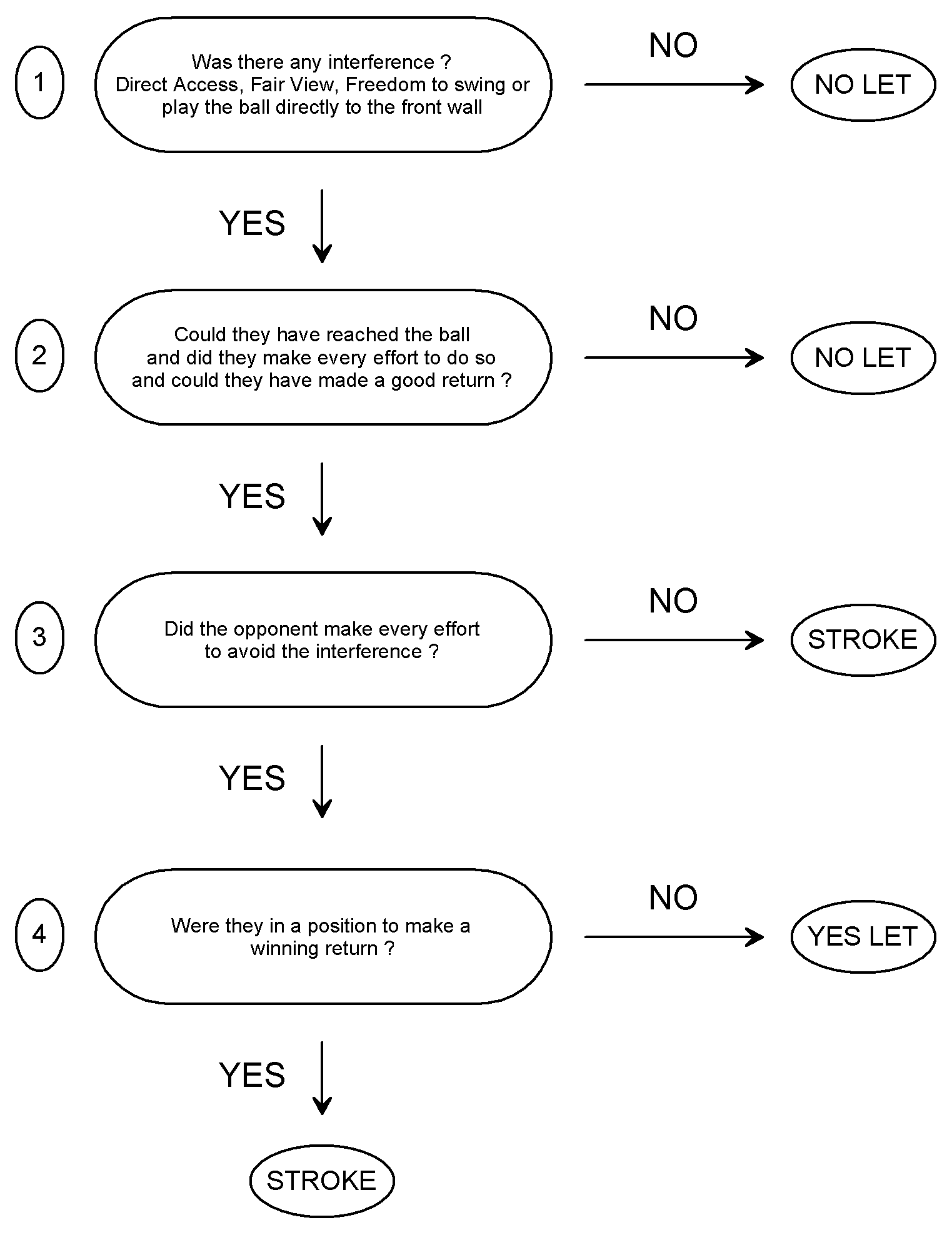INTERFERENCE - HOW TO DECIDE ON LETS AND STROKES
Refereeing is a thankless but necessary task.
Knowing the Rules and using the correct calls is expected of referees,
but the really difficult part is making decisions when one of the
players appeals for a let.
Below is a simple guide to help you make a decision
when asked 'Let Please'
The basic premis is
The striker has four basic rights,
and interference has occurred if the opponent fails to provide them with any
of these,
even if they have made every effort to do so :-
Unobstructed direct access
to the ball
(after completion of a reasonable follow-through by the opponent)
A fair view
of the ball on its rebound from the front wall
Freedom to hit
the ball with a reasonable swing
Freedom to play
the ball directly to the front wall
Also to be condisered is :-
Both players must make every effort
The ball must have been playable,
if there had been no interference
The striker it not allowed to manufacturer the interference
The striker can not choose the 'best of both worlds'.
If they play on past the interference and make an attempt at a
return,
they can not then ask for a LET
eg. if their shot is not as good as they had hoped.
LET's - the grey area
The difficult thing is knowing the difference between a LET and a STROKE.
Here is a simple approach to making your decision :-
If no interference has occurred,
or the interference was so minimal that the striker was not really effected,
then it's NO LET.
If interference has occurred but it was minimal,
then it's a LET.
If interference has occurred and was not minimal,
then it's a STROKE.
Interference - a decision tree that may be useful

Futher notes and considerations
It's only a game - relax and enjoy it, no point is worth
injuring another player (or yourself) for.
ANY chance of danger to either player - STOP, play a LET.
Think of the situation as -
an opponent is not allowed to impede the striker in any way.
If they do so,
then they are breaking the rules and have to concede the point,
unless it was 'minimal'.
The striker may stop play and ask for a let on the grounds
of safety.
If they feel the opponent is too close to them or the ball,
maybe behind them (so they can not see them to be sure),
or is in danger of hitting the opponent with the ball,
then a LET should be given.
'Freedom to play the ball directly to the front wall' -
this is not exactly true.
If the opponent is far enough off to the side,
such that any normal/reasonable shot would not hit the opponent,
then that is not the basis for awarding a STROKE.
If the striker would have to aim deliberately at the opponent,
then they are creating their own interference.
If the interference occurs as the strtiker is making their
attempt to play the ball and so is unable to stop their swing,
then they can still ask for a LET.
Point 4 of the decision tree -
the idea of 'play a winning return' is there to change what would
otherwise be a let,
into a stroke -
eg. if the interference is minimal,
but happens right up at the front wall
(eg. from a drop shot)
and the obstructing player is so out of position
that a decent drive would obviously be a winning shot.
This is also true if the striker were playing a reasonable boast,
so the ball is not going directly to the front wall.
Point 4 of the decision tree -
the logic of the 'play a winning return' becoming a stroke,
can not be used in reverse.
If a player tries to argue against the decision of a stroke
on the basis that the other player could not have played a winning
return,
that is not a valid argument.
The decision should be made with reference to the circumstances
at the time when the let is being asked for.
In particular -
if a player asks too early for a let,
before making an effort to get to the ball,
then the decision should be no let.
However -
if there is interference,
but the ball goes to the back wall and dies,
such that even if the player could move to the ball but it would
not have been playable,
then the decision should be no let.
Remember that this is a simplification —
the over-riding principle of the rules is to ensure a fair result for
both players.

